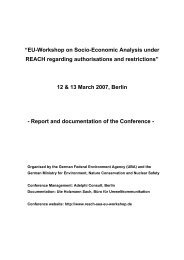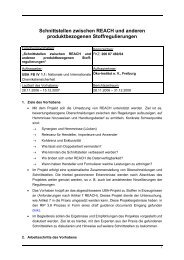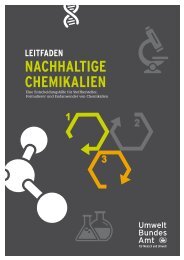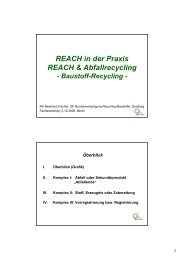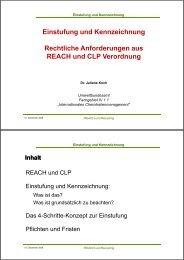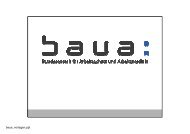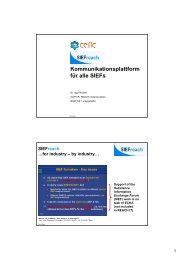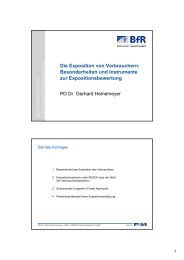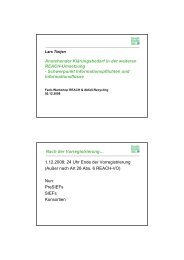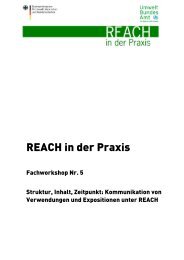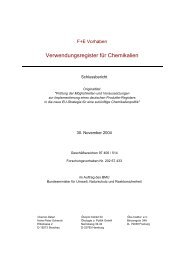PBT Assessment - REACh
PBT Assessment - REACh
PBT Assessment - REACh
You also want an ePaper? Increase the reach of your titles
YUMPU automatically turns print PDFs into web optimized ePapers that Google loves.
Guidance on information<br />
requirements and chemical safety<br />
assessment<br />
Part C: <strong>PBT</strong> <strong>Assessment</strong><br />
May 2008<br />
Guidance for the implementation of REACH
2<br />
LEGAL NOTICE<br />
This document contains guidance on REACH explaining the REACH obligations and how<br />
to fulfil them. However, users are reminded that the text of the REACH regulation is the<br />
only authentic legal reference and that the information in this document does not<br />
constitute legal advice. The European Chemicals Agency does not accept any liability with<br />
regard to the contents of this document.<br />
© European Chemicals Agency, 2008<br />
Reproduction is authorised provided the source is acknowledged.
PREFACE<br />
PART C – <strong>PBT</strong> ASSESSMENT<br />
This document describes the information requirements under REACH with regard to substance<br />
properties, exposure, use and risk management measures, and the chemical safety assessment. It is<br />
part of a series of guidance documents that are aimed to help all stakeholders with their preparation<br />
for fulfilling their obligations under the REACH regulation. These documents cover detailed<br />
guidance for a range of essential REACH processes as well as for some specific scientific and/or<br />
technical methods that industry or authorities need to make use of under REACH.<br />
The guidance documents were drafted and discussed within the REACH Implementation Projects<br />
(RIPs) led by the European Commission services, involving stakeholders from Member States,<br />
industry and non-governmental organisations. These guidance documents can be obtained via the<br />
website of the European Chemicals Agency (http://echa.europa.eu/about/reach_en.asp). Further<br />
guidance documents will be published on this website when they are finalised or updated.<br />
This document relates to the REACH Regulation (EC) No 1907/2006 of the European Parliament<br />
and of the Council of 18 December 2006 1<br />
1 Corrigendum to Regulation (EC) No 1907/2006 of the European Parliament and of the Council of 18 December 2006<br />
concerning the Registration, Evaluation, Authorisation and Restriction of Chemicals (REACH), establishing a European<br />
Chemicals Agency, amending Directive 1999/45/EC and repealing Council Regulation (EEC) No 793/93 and<br />
Commission Regulation (EC) No 1488/94 as well as Council Directive 76/769/EEC and Commission Directives<br />
91/155/EEC, 93/67/EEC, 93/105/EC and 2000/21/EC (OJ L 396, 30.12.2006); amended by Council Regulation (EC)<br />
No 1354/2007 of 15 November 2007 adapting Regulation (EC) No 1907/2006 of the European Parliament and of the<br />
Council on the Registration, Evaluation, Authorisation and Restriction of Chemicals (REACH) by reason of the<br />
accession of Bulgaria and Romania (OJ L 304, 22.11.2007, p. 1).<br />
3
PART C – <strong>PBT</strong> ASSESSMENT<br />
Convention for citing the REACH regulation<br />
Where the REACH regulation is cited literally, this is indicated by text in italics between quotes.<br />
Table of Terms and Abbreviations<br />
See Chapter R.20<br />
Pathfinder<br />
The figure below indicates the location of part C within the Guidance Document.<br />
4
CONTENTS<br />
PART C – <strong>PBT</strong> ASSESSMENT<br />
C.1 <strong>PBT</strong> AND VPVB ASSESSMENT ............................................................................... 7<br />
C.1.1 Aim and procedure ............................................................................................................................................. 7<br />
C.1.2 <strong>PBT</strong> and vPvB criteria ....................................................................................................................................... 7<br />
C.1.3 Comparison with the <strong>PBT</strong> and vPvB criteria .................................................................................................. 8<br />
C.1.4 Test strategies ................................................................................................................................................... 11<br />
C.1.4.1 Persistency ................................................................................................................................................ 11<br />
C.1.4.2 Bioaccumulation ....................................................................................................................................... 12<br />
C.1.4.3 Toxicity ..................................................................................................................................................... 13<br />
C.1.5 Conclusions on <strong>PBT</strong> or vPvB properties ........................................................................................................ 14<br />
C.1.6 Further actions if a substance is identified as a <strong>PBT</strong> or a vPvB ................................................................... 14<br />
TABLES<br />
Table C.1-1: <strong>PBT</strong> and vPvB criteria according to Annex XIII of the REACH Regulation ................................................ 9<br />
Table C.1-2: Screening criteria for Persistency, Bioaccumulation, and Toxicity ............................................................. 10<br />
5
C.1 <strong>PBT</strong> AND VPVB ASSESSMENT<br />
PART C – <strong>PBT</strong> ASSESSMENT<br />
A <strong>PBT</strong>/vPvB assessment is required for all substances for which a chemical safety assessment<br />
(CSA) must be conducted. These are in general all substances manufactured or imported in<br />
amounts of 10 or more tonnes per year that are not exempted from registration under REACH.<br />
However, some further exemptions apply, e.g. substances present in a preparation if the<br />
concentration is less than 0.1 % weight by weight (Article 14(2)), for on-site isolated (Art. 17)<br />
or transported intermediates (Art. 18), and for Product and Process Oriented Research and<br />
Development (Art. 9) (see Guidance on Registration, Section 1.8.1, for further information).<br />
C.1.1 Aim and procedure<br />
The objective of the <strong>PBT</strong>/vPvB assessment is to determine in a stepwise procedure:<br />
1. Whether the substance fulfils the criteria given in Annex XIII (comparision with the<br />
criteria) .<br />
If it is concluded that the substance is not a <strong>PBT</strong>/vPvB substance, the <strong>PBT</strong>/vPvB<br />
assessment stops after comparison with the criteria. An exposure and risk assessment as<br />
for a non-<strong>PBT</strong>/vPvB substance could however be required if the substances is dangerous<br />
in accordance with the classification criteria of Council Directive 67/548/EEC.<br />
2. If a substance is confirmed to be a <strong>PBT</strong>/vPvB substance, the registrant needs in a second<br />
step (emission characterisation; see Sections C.1.6 and R.11.2 for further guidance) to<br />
estimate the amounts of the substance released to the different environmental<br />
compartments during all activities carried out by the registrant and all identified uses. In<br />
addition, it is necessary to identify the likely routes by which humans and the environment<br />
are exposed to the substance.<br />
3. The registrant shall use the information obtained during the emission characterisation<br />
step, for implementing on his site, and recommending to downstream users, risk<br />
management measures (RMM) which minimise emissions and subsequent exposures of<br />
humans and the environment throughout the lifecycle of the substance that results from<br />
manufacture or identified uses.<br />
C.1.2 <strong>PBT</strong> and vPvB criteria<br />
A substance that fulfils all three of the criteria for persistence, bioaccumulation and toxicity<br />
described in Table C.1-1 is a <strong>PBT</strong> substance.<br />
It should however be noted that, even where a criterion is marginally not fulfilled, the overall<br />
evidence can be sufficient to justify the conclusion that a substance fulfils the Annex XIII<br />
criteria. This includes for example substances that do not fulfil the persistence criteria but<br />
bioaccumulate significantly and are measured in increasing levels over time in biota distant<br />
from anthropogenic sources (see Section R.11.1.5 for further guidance).<br />
7
PART C – <strong>PBT</strong> ASSESSMENT<br />
C.1.3 Comparison with the <strong>PBT</strong> and vPvB criteria<br />
The <strong>PBT</strong> and vPvB assessment of a substance shall be based on all the relevant information<br />
available, which is normally the information that shall be submitted as part of the technical<br />
dossier, including the physicochemical, hazard and exposure information generated in the<br />
context of the CSA. If the technical dossier, for one or more endpoints, contains only the<br />
information as required in Annexes VII and VIII, the registrant shall, based on screening<br />
criteria or other information available, consider whether further information needs to be<br />
generated to fulfil the objective of the <strong>PBT</strong> and vPvB assessment, i.e. to assess whether the<br />
substance fulfils the criteria. Hence, it is task of the registrant to assess if the information that<br />
is available and/or produced is sufficient to conclude whether the substance is a <strong>PBT</strong> or a<br />
vPvB substance or not. In many cases further information as detailed in Annexes IX and X of<br />
the Regulation may need to be generated before it can be judged whether the substance fulfils<br />
the Annex XIII criteria. Generally, before generating information detailed in Annexes IX and<br />
X, a testing proposal needs to be submitted to and authorised by the ECHA.<br />
The <strong>PBT</strong> assessment is initiated by an evaluation of all available information. For substances<br />
below a volume of 100 t/y normally data on ready biodegradability, octanol-water partitioning<br />
coefficient (log Kow) and environmental toxicity are available that give an indication on the<br />
P, B and T properties of a substance.<br />
8
PART C – <strong>PBT</strong> ASSESSMENT<br />
Table C.1-2 gives an overview of information that can be used for a screening assessment and<br />
provides criteria to decide whether an in depth assessment on the <strong>PBT</strong> or vPvB properties is<br />
necessary.<br />
When the screening criteria do not clearly indicate that there is no concern that the substance<br />
could meet the Annex XIII criteria (Table C.1-1), a stepwise approach is followed for the<br />
definitive assessment of the P, B and T criteria, which is further outlined below.<br />
Table C.1-1: <strong>PBT</strong> and vPvB criteria according to Annex XIII of the REACH<br />
Regulation<br />
Property <strong>PBT</strong>-criteria vPvB-criteria<br />
Persistence 1<br />
Bioaccumulation 2<br />
- T1/2 > 60 days in marine water, or<br />
- T1/2 > 40 days in fresh- or estuarine water, or<br />
- T1/2 > 180 days in marine sediment, or<br />
- T1/2 > 120 days in fresh- or estuarine sediment,<br />
or<br />
- T1/2 > 120 days in soil.<br />
- T1/2 > 60 days in marine,<br />
fresh- or estuarine water,<br />
or<br />
- T1/2 > 180 days in<br />
marine, fresh- or<br />
estuarine sediment, or<br />
- T1/2 > 180 days in soil.<br />
BCF > 2000 L/kg BCF > 5000 L/kg<br />
Toxicity - NOEC < 0.01 mg/L for marine or freshwater<br />
organisms, or<br />
Screening assessment<br />
- substance is classified as carcinogenic<br />
(category 1 or 2), mutagenic (category 1 or 2),<br />
or toxic for reproduction (category 1, 2 or 3),<br />
or<br />
- there is other evidence of chronic toxicity, as<br />
identified by the classifications: T, R48, or<br />
Xn, R48 according to Directive 67/548/EEC.<br />
The screening criteria (Table C.1-2) should always be considered in conjunction for P, B and<br />
T to decide whether the substance has to be regarded as a potential <strong>PBT</strong>/vPvB. It has to be<br />
kept in mind that the fact that a substance does not meet the T criterion is not enough to stop<br />
the evaluation of the remaining endpoints in the <strong>PBT</strong>/vPvB screening step. Similarly,<br />
conflicting evidence arising from further information, e.g. monitoring data indicating potential<br />
P or B properties, needs to be considered in the assessment and the overall conclusion on the<br />
<strong>PBT</strong> or vPvB properties (see Section R.11.1.5 for further guidance).<br />
-<br />
9
PART C – <strong>PBT</strong> ASSESSMENT<br />
10<br />
Table C.1-2: Screening criteria for Persistency, Bioaccumulation, and Toxicity 2<br />
Type of data Criterion Screening<br />
assignment<br />
Persistence<br />
Ready biodegradability test Readily biodegradable Not P and<br />
not vP<br />
Enhanced ready biodegradability test Readily biodegradable Not P and<br />
not vP<br />
Specified tests on inherent<br />
biodegradability<br />
Zahn-Wellens (OECD 302B)<br />
MITI II test (OECD 302C)<br />
Biowin 2 (non-linear model prediction)<br />
and Biowin 3 (ultimate biodegradation<br />
time)<br />
or<br />
Biowin 6 (MITI non-linear model<br />
prediction) and Biowin 3 (ultimate<br />
biodegradation time)<br />
Bioaccumulation<br />
Convincing evidence that a substance can<br />
biomagnify in the food chain (e.g. field<br />
data)<br />
Octanol-water partitioning coefficient<br />
(experimentally determined or estimated<br />
by QSAR)<br />
Toxicity<br />
≥ 70 % mineralisation (DOC removal)<br />
within 7 d; log phase no longer than<br />
3d; removal before degradation occurs<br />
below 15%; no pre-adapted inoculum<br />
≥ 70% mineralisation (O2 uptake)<br />
within 14 days; log phase no longer<br />
than 3d; no pre-adapted inoculum<br />
Does not biodegrade fast (probability<br />
Definitive assessment<br />
PART C – <strong>PBT</strong> ASSESSMENT<br />
If, on the basis of the screening assessment, a substance is considered to potentially fulfil the<br />
criteria for P, B and T or for vP and vB, the registrant may choose to treat the substance as a<br />
<strong>PBT</strong>/vPvB-substance and report accordingly in the chemical safety report without further<br />
evaluation of the properties.<br />
If the registrant decides to further evaluate the properties of a substance that based on the<br />
screening assessment potentially fulfils the <strong>PBT</strong> or vPvB criteria, a definitive assessment of<br />
P/vP should be conducted first. Definitive assessment of P/vP should normally be based on<br />
half-life data collected under adequate conditions for the relevant compartment(s) of exposure<br />
(see Section C.1.4.1).<br />
If the substance is considered to fulfil the P and/or vP criterion, the <strong>PBT</strong>/vPvB assessment is<br />
continued by evaluation of the B/vB criterion. Definitive assessment of B/vB should normally<br />
be based on measured data on bioconcentration in aquatic species (see Section C.1.4.2).<br />
If the substance is not identified as vPvB but considered to fulfil the P and B criteria, the <strong>PBT</strong><br />
assessment is continued by evaluation of the T criterion. Definitive assessment of T should be<br />
based on evaluation of the data for classification of the substance for human health hazards<br />
and/or on no-observed effect concentration(s)(NOECs) from long-term toxicity tests with<br />
aquatic organisms (see Section C.1.4.3).<br />
However, for substances for which persistency testing is difficult or practically impossible,<br />
like e.g. for certain multi-constituent or very poorly water soluble substances, it may<br />
sometimes be more reasonable to start the <strong>PBT</strong>/vPvB assessment by evaluating the B criterion<br />
(see Section R.11.1.3.2 for further guidance).<br />
C.1.4 Test strategies<br />
C.1.4.1 Persistency<br />
The detailed testing strategy on degradation for <strong>PBT</strong>/vPvB assessment is set out in Section<br />
R.11.1.3.1 and Figure R.11-1. It is based on a weight of evidence approach starting with the<br />
review of all available screening test data and non-test data ((Q)SAR model predictions, read<br />
across, and chemical categorisation). The criteria for the screening methods are given in Table<br />
C.1-2. In some cases, the performance of an enhanced ready biodegradation test may deliver<br />
sufficient information to draw the conclusion that the substance can be considered as "not P".<br />
If persistency cannot be excluded, it should be determined which compartments are likely to<br />
be exposed, and hence which simulation tests need to be conducted. This determination of the<br />
compartments(s) for simulation testing should take account of the intrinsic properties of the<br />
substance (e.g. water solubility, vapour pressure, log Kow, Kp, Koa, half-life in air) that are<br />
significantly influencing the environmental fate of the substance. Multi-media modelling (e.g.<br />
Mackay level 3 models) may also be used in order to determine the environmental<br />
compartment(s) of primary concern.<br />
Soil/sediment simulation degradation testing is warranted if the screening data indicate<br />
potential persistency and direct or indirect exposure of these compartments is likely. This<br />
includes cases where a substance is released to surface water but due to high sorption<br />
11
PART C – <strong>PBT</strong> ASSESSMENT<br />
partitions to sediment or sewage sludge, which may be spread on soil, or where a substance is<br />
volatilised from water to air and deposited to soil.<br />
The Kp (sediment) may be used as an indicator of whether testing in a water-sediment system<br />
may be warranted. For example, it may be considered to conduct an aquatic sediment<br />
simulation test in addition to a pelagic simulation test for substances with Kp (sediment) ><br />
2000.<br />
C.1.4.2 Bioaccumulation<br />
A detailed test strategy for bioaccumulation testing for <strong>PBT</strong>/vPvB assessment is set out in<br />
Section R.11.1.3.2 and Figure R.11-2. In general, all existing information on the<br />
bioaccumulation potential of a substance should be collected and evaluated first before a<br />
decision on the necessity to conduct further testing is drawn. The existing data may include<br />
laboratory bioconcentration tests (aquatic, terrestrial and benthic) and field studies on<br />
biomagnification or bioaccumulation. Such available information might be sufficient to<br />
conclude whether the substance is vB, B, or not B (see Section R.11.1.3.2).<br />
If the above mentioned information is not available for a substance produced or imported at a<br />
level of less than 100 t/y and the substance has a log Kow ≤ 4.5 and no specific uptake<br />
mechanism apart from lipophilic partitioning is known or suspected, then the substance can be<br />
considered as not B and not vB and further evaluation of the B and vB criteria is not<br />
necessary.<br />
However, for a substance produced or imported at a level of 100 t/y or more, information on<br />
bioconcentration in aquatic species has to be made available by the registrant and to be<br />
considered in the assessment, unless this information can be waived according to column 2 of<br />
Annex IX or according to Annex XI(3) (e.g. low bioaccumulation potential, no exposure,<br />
testing technically not possible).<br />
In other cases, where:<br />
• no direct data on bioconcentration are available and the substance has a log Kow > 4.5, or<br />
the partitioning process into aquatic organisms is not driven by lipophilicity ;<br />
• direct data on bioconcentration are available but these data are not reliable and/or<br />
consistent to a degree sufficient to conclude whether the B or vB criteria are met;<br />
the B and vB properties should be evaluated in more detail.<br />
In this further evaluation, non-testing data should be used as indicators for limited<br />
bioaccumulation in a weight of evidence assessment together with supplementary information<br />
to examine whether the substance potentially meets the B and vB criteria. Because the<br />
indicators for limited bioaccumulation (e.g. molecular weight and size of the molecule,<br />
octanol solubility or log Kow) are on their own considered to be insufficient to abstain from<br />
confirmatory testing, the availability of other reliable information indicating a low<br />
bioaccumulation potential is essential. This supplementary information may comprise data<br />
showing no toxicity in a chronic toxicity study with mammals, no uptake in a toxicokinetic<br />
study, or it could be a bioconcentration study with invertebrates or reliable read-across from a<br />
structurally similar compound. Evidence of significant uptake of a substance in fish or<br />
mammals after prolonged exposure is a contraindication to using the above indicators of<br />
limited bioconcentration.<br />
12
C.1.4.3 Toxicity<br />
PART C – <strong>PBT</strong> ASSESSMENT<br />
A detailed test strategy for toxicity testing for <strong>PBT</strong>/vPvB assessment is set out in Section<br />
R.11.1.3.3 and Figure R.11-3. The strategy starts with the evaluation of the classification of<br />
the substance. If any classification criterion leading to the assignment of the R-phrases R45,<br />
R46, R48, R49, R60 – R63 is met, the substance fulfils the T criterion 3 and there is no need to<br />
perform any further aquatic studies for T assessment.<br />
When no such classification is assigned, data on aquatic toxicity should be evaluated. When<br />
no chronic toxicity data are available, a substance is considered to meet the T-criterion when<br />
an acute L/EC50 value from a standard toxicity (or reliable non-standard) test is < 0.01 mg/l.<br />
When the L/EC50 is < 0.1 mg/l, the substance is considered to meet potentially the Tcriterion,<br />
and consequently the substance is referred to definitive T testing and chronic studies<br />
are required (regardless of the tonnage band). Note however that, due to animal welfare<br />
concerns, the general scheme of testing and confirming first P and B should be applied before<br />
further T-testing is considered. Also, vertebrate-animal testing should be minimised by first<br />
testing non-vertebrate species. Normally, the testing order for conclusion on T based on<br />
chronic data is Daphnia and then fish 4 , unless there is evidence that fish are more sensitive<br />
than daphnia. If the T-criterion is fulfilled by the chronic algae or Daphnia data, a chronic fish<br />
test is not necessary. If however a long term test on Daphnia or algae provides a NOEC close<br />
to but above 0.01 mg/l, a long-term fish study is likely to be needed to confirm “not T”.<br />
For certain lipophilic substances (with a log Kow >5) acute toxicity may not occur at the limit<br />
of the water solubility of the substance tested (or the highest concentration tested). In such<br />
situations, chronic toxicity with a NOEC 0.1 mg/l, because these substances may not<br />
have had sufficient time in the acute test to be significantly taken up by the test organisms and<br />
to reach equilibrium partitioning. (see Section R.11.1.3.3, ITS for T-testing, Figure R.11-3<br />
and decision tree Steps 2, 5 & 6).<br />
In the absence of definitive information on T, for substances with very high lipophilicity, a<br />
weight of evidence or group approach for long term toxicity may be used to predict whether<br />
long term effects are likely to occur. If convincing evidence is available that aquatic toxicity<br />
is not expected to occur at
PART C – <strong>PBT</strong> ASSESSMENT<br />
C.1.5 Conclusions on <strong>PBT</strong> or vPvB properties<br />
A detailed analysis of the persistence, bioaccumulation and toxicity should be brought<br />
together into a clear conclusion on whether the substance should be treated as a <strong>PBT</strong>/vPvB<br />
substance. There are a number of conclusions from this comparison that call for different<br />
responses from a registrant (see Section R.11.1.5 for further guidance).<br />
(i) The data show that the properties of the substance meet the specific criteria detailed in<br />
Annex XIII, or do not allow a direct comparison with all the criteria in Annex XIII, but<br />
nevertheless indicate that the substance would have these properties<br />
In this case an emission and risk characterisation for <strong>PBT</strong>/vPvB substances in accordance<br />
with the stipulations of Annex I is required.<br />
(ii) The data show that the properties of the substance do not meet the specific criteria<br />
detailed in Annex XIII or do not allow a direct comparison with all the criteria in Annex<br />
XIII but nevertheless indicate that the substance would not have these properties and the<br />
substance is not considered a <strong>PBT</strong>/vPvB<br />
In this case the <strong>PBT</strong>/vPvB assessment stops at this point. An exposure assessment and<br />
risk characterisation as for a non-<strong>PBT</strong>/vPvB substance may however be required if the<br />
substance is dangerous in accordance with the classification criteria of Council Directive<br />
67/548/EEC.<br />
(iii) The data on the properties of the substance do not allow a direct comparison with all the<br />
criteria in Annex XIII and further information is needed<br />
In this case a registrant has two options:<br />
• The registrant generates the required information (depending on the information<br />
needed, the submission of a testing proposal may be required) and concludes on the<br />
<strong>PBT</strong>/vPvB properties of the substance concerned once the lacking data are available<br />
(i.e. conclusion (i) or (ii)); or<br />
• The registrant refrains from generating further information and treats his substances as<br />
if it were a <strong>PBT</strong>/vPvB.<br />
(iv) Further information would be needed to conclude on the <strong>PBT</strong>/vPvB properties of the<br />
substance. However, the registrant (for several reasons) has decided not to conduct<br />
confirmatory testing.<br />
If a clear decision on the properties of a substance cannot be made, either because it is<br />
not possible to characterise a substance, or since it is technically not possible to conduct<br />
testing, this lack of a clear decision does not obviate the requirement on a registrant to<br />
propose appropriate and proportionate RMMs and OCs.<br />
C.1.6 Further actions if a substance is identified as a <strong>PBT</strong> or a vPvB<br />
If it is concluded that the substance is a <strong>PBT</strong> or vPvB substance, or that it should be treated as<br />
such, the registrant must conduct an emission characterisation and a risk characterisation for<br />
<strong>PBT</strong>/vPvB substances in accordance with Article 14 (4).<br />
Generally, if a substance contains one or more constituents with <strong>PBT</strong>/vPvB properties in<br />
individual amounts ≥ 0.1 % (w/w) or if transformation/degradation products with the<br />
respective properties in amounts ≥ 0.1 % are being generated, the substance must be subjected<br />
14
PART C – <strong>PBT</strong> ASSESSMENT<br />
to <strong>PBT</strong>/vPvB specific emission characterisation and risk characterisation. However, for the<br />
sake of relevance of risk exerted by the amount of a <strong>PBT</strong>/vPvB substance<br />
manufactured/imported by a registrant, and hence with regard to the requirements for risk<br />
characterisation and nature of RMM to be implemented, it may be considered to use a<br />
threshold value of 10% (w/w) for the total of all constituents or transformation/degradation<br />
products having <strong>PBT</strong> or vPvB properties, if it is possible to estimate with sufficient certainty<br />
that the total manufacture/import or supply of <strong>PBT</strong>/vPvB constituents in that substance and<br />
the total amount of degradation/transformation products with <strong>PBT</strong>/vPvB properties generated<br />
by that substance do not exceed 1 t/y 5 . In the considerations as to whether application of this<br />
percentage trigger could be appropriate, the use pattern of the substance and the potential<br />
emissions of the constituents or transformation/degradation products having <strong>PBT</strong> or vPvB<br />
properties must be accounted for.<br />
The main objective of the emission characterisation is to estimate the amounts of the<br />
substance released to the different environmental compartments and to identify the likely<br />
routes by which humans and the environment are exposed to the substance. A registrant has<br />
only to take care of his own tonnage 6 . In co-operation with his downstream users he has to<br />
cover, where relevant, any manufacture in the EU he is responsible for, his own uses and all<br />
identified uses including all resulting lifecycle stages.<br />
The principal tool to achieve this objective is exposure scenarios (ES(s)). Part D and Chapters<br />
R.12 to R.18 provide guidance on how to develop ESs for substances in general. Parts of the<br />
exposure assessment guidance are relevant also for <strong>PBT</strong>/vPvB substances (i.e. emission<br />
estimation and assessment of chemical fate and pathways). However, since the objectives are<br />
not the same the general scheme for exposure assessment needs to be adapted to the<br />
requirements of emission characterisation for <strong>PBT</strong>/vPvB substances. Below guidance is given<br />
on some issues where special considerations are needed for <strong>PBT</strong>/ vPvB substances. In the<br />
context of the emission characterisation, the registrant needs to develop ES(s) for all<br />
identified uses of his <strong>PBT</strong>/vPvB substance, unless he concludes to advise in his technical<br />
dossier (and SDS) against certain uses of his substance. In this latter case he does not need to<br />
perform an emission characterisation or other risk management work related to these uses.<br />
As <strong>PBT</strong>s and vPvBs are substances of very high concern, the registrant shall pay special<br />
attention to the level of detail of his assessment and whether its accuracy and reliability is<br />
sufficient for a <strong>PBT</strong>/vPvB substance. Where generic scenarios and assumptions may be<br />
sufficient for exposure assessment of non <strong>PBT</strong>/vPvB-substances, specific scenarios and data<br />
will most likely be needed throughout an emission characterisation for <strong>PBT</strong>/vPvB-substances.<br />
All effort necessary should be made to acquire for manufacture and any identified use<br />
throughout the lifecycle, site- and product-specific information on emissions and likely routes<br />
by which humans and the environment are exposed to the substance. The emission<br />
5 Please note that the proposed one tonne per year threshold for the total of compounds with <strong>PBT</strong>/vPvB properties in a<br />
substance consisting of more than one component (be it a preparation or a multi-constituent substance) is not an<br />
‘allowable release’ threshold. It refers instead to the content in a substance that will need to have appropriate risk<br />
assessment and management justified in the chemical safety report. 1 t/y is the level at which the registration<br />
requirement under REACH normally begins to apply if a substance was supplied alone or in a preparation. 1 t/y is<br />
also the trigger for registration in an article. Therefore, this amount is considered to be a suitable threshold level for<br />
relevance and hence adaptation of required risk assessment efforts and, depending on the results of risk assessment,<br />
possibly risk management measures.<br />
6 However, it can be useful to consider on a voluntary basis exposure resulting from emissions of the same substance<br />
manufactured or imported by other registrants (i.e., the overall estimated market volume), c.f. Part A.2.1.<br />
15
PART C – <strong>PBT</strong> ASSESSMENT<br />
characterisation shall in particular be specific in the use description and concerning RMMs,<br />
and shall furthermore contain an estimation of the release rate (e.g. kg/year) to the different<br />
environmental compartments during all activities carried out during manufacture or identified<br />
uses (see Section R.11.2.1 for further guidance).<br />
The objective of a risk characterisation for substances satisfying the <strong>PBT</strong> or vPvB criteria is to<br />
use the information obtained in the emission characterisation step to implement on a<br />
registrant's site or to recommend to his downstream users RMMs which minimise exposures<br />
and emissions to humans and the environment throughout the lifecycle of the substance that<br />
results from manufacture or identified uses (Annex I (6.5)). To this end, the minimisation of<br />
exposures and emissions to humans and the environment needs to be considered throughout<br />
the development of ES(s). The need or a potential to (further) minimise emissions or exposure<br />
may therefore be recognised at any point in the development of an ES. In this way, the<br />
appropriateness and effectiveness of RMMs and OCs should be assessed in the development<br />
of the ES.<br />
Suitable options and measures to minimise emissions of and exposure to a <strong>PBT</strong>/vPvB<br />
substance are, for instance, substitution of the substance or reduction of its use when<br />
technically possible, manufacture and use under strictly controlled conditions and handling of<br />
the substance by trained personal only (see Section R.11.2.2 for further guidance).<br />
The final ES, or ES(s) in case of different uses, shall be presented under the relevant heading<br />
of the chemical safety report, and included in an annex to the SDS. It shall describe the<br />
required OCs and RMMs in a way that downstream users can check whether they have to<br />
implement any measures in order to minimise emissions or exposures of humans and the<br />
environment.<br />
16



